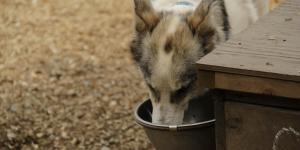My Dog Is Not Eating But Is Drinking Water



See files for Dogs
Any physical symptoms or behavioral changes in our dogs which may indicate illness need to be understood in context of their situation. Various pathologies and health conditions can cause either a lack of appetite (anorexia) or an increased water consumption (polydipsia) in dogs. When the two clinical signs occur simultaneously, it can better help our veterinarian achieve and accurate diagnosis. Generally, these symptoms appear in combination with other clinical manifestations, the combination of which can also help diagnose the dog's issue.
At AnimalWised, we examine why my dog is not eating, but is drinking a lot of water. We look at the main pathological causes of this clinical picture in canines and the possible treatment options available.
Chronic kidney disease
Chronic kidney disease (CKD) is the most common kidney disease in dogs,. Moreover, it is the third leading cause of death in geriatric dogs. This disease is characterized by the appearance of kidney damage that leads to progressive, permanent and irreversible loss of kidney function, also known as renal failure in dogs.
This kidney dysfunction causes:
- Uremia: the accumulation of toxic substance sin the blood which can lead to various clinical signs, including causing the dog to not eat.
- Ployuria: as a compensatory mechanism, the nephrons (functional units of the kidney) that survive kidney damage increase their filtration, resulting in a an increase of urine production. For the dog to prevent dehydration, they try to compensate for increased urine output by consuming a larger volume of water (i.e. drinking a lot).
In addition to anorexia and polydipsia, CKD can present with a wide variety of other clinical signs. These include:
- Depression
- Weight loss
- Vomiting and diarrhea
- Dehydration
- Encephalopathy
- Uremic stomatitis
- Hemorrhagic diathesis (predisposition to bleeding)
- Anemia
- Blindness
- Bone alterations
Unfortunately, there is no curative treatment of chronic kidney disease in dogs. Treatment of the disease is based on symptom management and nephroprotective interventions. Vasodilator drugs such as ACE inhibitors and a diet for dogs with kidney disease (low in protein, sodium and potassium, but rich in omega 3 fatty acids, soluble fiber and antioxidants) are normally used.
Addison's disease (hypoadrenocorticism)
Addison's disease in dogs is an endocrine pathology characterized by a deficiency of hormones produced by the adrenal cortex. These hormones are mainly cortisol and aldosterone.
In dogs with Addison's disease, sometimes known as Addison's syndrome, it is common to find loss of appetite that evolves into complete anorexia. Although this means the dog will stop eating at all, they will still likely have an increased water consumption (polydipsia). In addition, it is common to observe other symptoms, such as:
- Increased urine volume (polyuria)
- Weakness, depression and weight loss
- Vomiting, diarrhea and abdominal pain
- Hypothermia
- Tremors and seizures
- Blindness
Management of this disease requires lifelong treatment based on glucocorticoids (hydrocortisone or prednisone) and mineralocorticoids (fludrocortisone or desoxycorticosterone pivalate). It should be noted that, although there is no specific therapy against Addison's disease, the prognosis of these patients is excellent if the treatment described is followed.
Many of these symptoms are concurrent with various canine medical conditions, something you can learn more about in our article on why a dog has vomiting and diarrhea at the same time.

Liver disease
The first signs commonly observed in dogs with liver disease are non-specific symptoms. These include the dog eating less, but still drinking a lot. Others include depression, polyuria, vomiting, diarrhea, weight loss, etc.
After a first phase of nonspecific symptoms, the following specific signs suggestive of liver disease usually appear:
- Jaundice: yellowish discoloration of the mucous membranes.
- Ascites: accumulation of fluid in the abdominal cavity.
- Neurological signs: due to of hepatic encephalopathy (brain disorder as a result of liver damage).
- Bleeding: will be more likely to bleed and may bleed more.
- Uroliths: stones and deposits in the urinary tract which often appear as crystals in the dog's urine.
The treatment of liver diseases in dogs varies depending on the specific underlying pathology. It can be addressed medically and/or surgically. In addition, hepatoprotectors and antioxidants, such as ursodeoxycholic acid, vitamin E or silymarin, are often administered.
Hypercalcemia
Hypercalcemia in dogs refers to increased calcium levels in their blood. It can occur in association with a wide variety of pathologies, including:
- Tumors: the main cause of hypercalcemia in dogs, the most typical being lymphosarcoma, adenocarcinoma of the anal sacs and other carcinomas.
- Primary hyperparathyroidism: produced by a direct affection of the parathyroid gland.
- Renal hyperparathyroidism: appears in dogs with chronic kidney disease.
- Nutritional hyperparathyroidism: as a consequence of diets very rich in meat (especially raw meat) which are high in phosphorus and poor in calcium and vitamin D3. It is becoming more frequent, due to raw food and BARF diets for dogs.
- Poisoning: due to accidental ingestion of rodenticides or some drugs.
In addition to anorexia and polydipsia, hypocalcemia can produce signs such as:
- Polyuria
- Weakness and lethargy
- Vomiting
- Constipation
- Arrhythmias
- Seizures
- Muscle tremors
Since there is no single and effective protocol for all causes of hypercalcemia, it is necessary to identify the underlying cause and establish a specific therapy, whenever possible. If there is no specific treatment, supportive therapy including fluid therapy, corticosteroids, diuretics and bisphosphonates should be instituted to increase urinary calcium excretion and prevent calcium reabsorption in the bones.
Hypercalcemia can also result in hardened plaques appearing on the skin. Our article on calcinosis cutis in dogs explains more.
Hypokalemia or hypokalemia
Hypokalemia is a decrease in potassium levels in the blood. In dogs, it usually occurs as a result of:
- Renal potassium loss: in chronic kidney disease, tubular acidosis, etc.
- Gastrointestinal loss: as a consequence of vomiting and/or profuse diarrhea, because the gastrointestinal content is rich in potassium.
Dogs with hypokalemia often have loss of appetite and increased water consumption. In addition, it is common to observe:
- Polyuria
- Generalized muscle weakness
- Lethargy and confusion
- Tachycardia
Treatment of hypokalemia should focus on:
- Administering to the underlying disease that causes low potassium levels.
- Replenishing calcium levels either orally or parenterally through fluid therapy.

pyometra
Another issue that can mean female dogs are not eating, but still drinking a lot of water, is pyometra. This is the most frequent uterine pathology in bitches that have reached sexual maturity. Specifically, pyometra in dogs consists of a purulent infection of the uterus that occurs when progesterone levels are high, something that occurs in the weeks following their heat cycle.
In addition to the symptoms already mentioned, dogs with pyometra usually present:
- Bloody and purulent vaginal discharge
- Fever
- Lethargy and depression
- Polyuria
- Vomiting and diarrhea
- Abdominal dilation
There two different types of pyometra in dogs, open and closed. Vaginal discharge in dogs can be seen when the cervix remains open, but not when it is closed. The latter is particularly dangerous due to internal accumulation of discharge.
In severe cases or in the absence of veterinary treatment, serious complications such as septicemia, toxemia, peritonitis and kidney failure can occur. These can have fatal consequences. As soon as the infection is diagnosed, it is essential to establish a treatment, which will be medical or surgical depending on the severity of the process.
We need to be observant of any abnormal change in our dog's health or behavior. With pyometra, one early sign may be that the dog keeps licking their private area.

This article is purely informative. AnimalWised does not have the authority to prescribe any veterinary treatment or create a diagnosis. We invite you to take your pet to the veterinarian if they are suffering from any condition or pain.
If you want to read similar articles to My Dog Is Not Eating But Is Drinking Water, we recommend you visit our Other health problems category.







